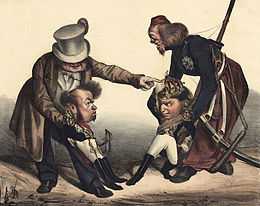Miguelist

In the history of Portugal, a Miguelist (in Portuguese Miguelista) was a supporter of the legitimacy of the king Miguel I of Portugal. The name is also given to those who supported absolutism as form of government, in opposition to the liberals who intended the establishment of a constitutional regime in Portugal.
Miguel was regent to his niece Queen Maria II of Portugal, and potential royal consort. However, he claimed the Portuguese throne in his own right once, according to the so-called Fundamental Laws of the Kingdom, his older brother Pedro IV and therefore his daughter, had lost their rights from the moment that Pedro had made war on Portugal and become the sovereign of a foreign state (Brazilian Empire).
This led to a difficult political situation, during which many people were killed, imprisoned, persecuted or sent into exile, and which culminated in the Portuguese Liberal Wars between authoritarian Absolutists (lead by Miguel) and progressive Constitutionalists (lead by Pedro).
In the end, Miguel was forced from the throne and lived the last 32 years of his life in exile.
Miguelism is not only based on the question of who should legitimately sit on the Portuguese throne. It also defends the traditional principles of a conservative monarchy based in Roman Catholic values and in the absolute power of the king, against the Enlightenment values.
Miguelist Braganzas
King Miguel I was exiled following the Convention of Evora-Monte (1834), which put an end to the Liberal Wars. The throne was retaken by his niece, Queen Maria II, and a liberal regime was setlled.
In exile, the former king married a wealthy Bavarian heir, princess Adelheid of Loewenstein-Wertheim-Rosenberg. This marriage was the origin of the new Miguelist branch of the Braganzas and their descendants include not only the current claimant to the Portuguese crown, as well as the monarchs of Belgium, Luxembourg, Liechtenstein, and other claimants to former European monarchies (Habsburgs, Austria-Este, Savoy, Wittelsbach, Bourbon-Parma, Thurn und Taxis, Ligne).
Finally, this Miguelist branch, became the sole Braganzas representative when King Manuel II of Portugal (the last male Braganza from the senior liberal branch) died without issue and, naturally, his Miguelist cousin Duarte Nuno, was his closest Portuguese relative and heir.
Genealogical Chart
On the family tree bellow, the Miguelist branch is clearly identified on the right hand side.
| John VI [1767-1826] King of the U. K. of Portugal, Brazil & the Algarves 1816-22 King of Portugal & the Algarves 1822-1826 | |||||||||||||||||||||||||||||||||||
| Pedro I / IV [1798-1834] Emp. of Brazil 1822-31 King of Portugal 1826 | Miguel I [1802-1866] Regent (to his niece) 1828 King of Portugal 1828-34 Legitimist claimant 1834-66 | ||||||||||||||||||||||||||||||||||
| Pedro II [1825-1891] Emp. of Brazil 1831-89 deposed (1889) | Maria II [1819-1853] Queen of Portugal 1826-28, 1834-53 | Fernando II [1816-1885] Prince of Saxe-Coburg and Gotha Prince Consort 1836-37 King Consort 1837-53 | |||||||||||||||||||||||||||||||||
| Pedro V [1837-1861] King of Portugal 1853-61 | Luis I [1838-1889] King of Portugal 1861-89 | Miguel (II) [1853-1927] Legitimist claimant 1866-1920 | |||||||||||||||||||||||||||||||||
| Carlos I [1863-1908] King of Portugal 1889-1908 | |||||||||||||||||||||||||||||||||||
| Brazilian Imperial family | Manuel II [1884-1932] last King of Portugal 1908-10 deposed (1910), without issue | Duarte Nuno [1907-1976] Legitimist claimant 1920-32 Royalist claimant 1932-76 | |||||||||||||||||||||||||||||||||
| Duarte Pio [born 1945] Duke of Braganza Current claimant (since 1976) | |||||||||||||||||||||||||||||||||||